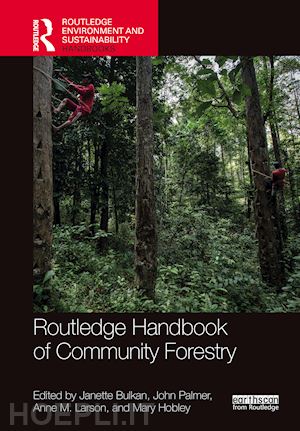1. IntroductionJanette Bulkan, John Palmer, Anne M. Larson, and Mary Hobley Part 1. Spaces for community forestry in State- and timber-dominated landscapes 2. The difficult art of carving space(s) for community forestry in the Quebec regime.Luc Bouthillier, Guy Chiasson, and Hanneke Beaulieu 3. Community forestry in extractive reserves: The story of Verde para Sempre in Pará State, Brazil.Katiuscia Fernandes Miranda, Manuel Amaral Neto, and Alison Pureza Castilho Part 2. Multi-level governance and new governance approaches – Global 4. Non-timber forest product value chain development: Lessons from a University’s 20-year partnership in the Maya Biosphere Reserve. Megan Butler, David Wilsey, Dean Current, José Román Carrera, and Deanna Newsom 5. Pathways to community timber production: A comparative analysis of two well-established community-based forest enterprises in Mexico and Brazil.Shoana Humphries, Karen A. Kainer, Dawn Rodriguez-Ward, Ana Luiza Violato Espada, Thomas P. Holmes, Pascual Blanco Reyes, Jones da Silva Santos, and Maria Margarida Ribeiro da Silva 6. Social Forestry and forest tenure conflicts in Indonesia. Myrna Safitri 7. Commercial timber plantations as a means to land and economic restitution in South Africa. Ratsodo Phillip Tshidzumba, Jeanette Clarke and Paxie W. Chirwa 8. Community forestry in Australia: Caring for Country, land, and the bush.Giselle Cruzado Melendez and Peter Kanowski Part 3. Inter-agency collaborations in Community Forestry – USA 9. Old World and New World collision: Historic land grabs and the contemporary recovery of Indigenous land management practices in the western USA.Janette Bulkan, John Palmer, Anne M. Larson, and Mary Hobley 10. Community forest ownership, rights, and governance regimes in the United States.Kathleen A. McGinley, Susan Charnley, Frederick W. Cubbage and Reem Hajjar, Gregory E. Frey, John Schelhas, Meredith Hovis, and Kailey Kornhauser 11. Community-based forestry in the western United States: Reimagining the role of communities in federal forest management.Cecilia Danks and Yvonne Everett 12. The Weaverville Community Forest: Putting community in the forest.Patrick Frost and Kelly Sheen 13. Community management of Native American, municipal, and private managedforests in northern California, USA.Bill Wilkinson and April Sahara Part 4. Voluntary forest certification schemes in community forestry 14. Unfinished business: Rethinking certification for smallholders in Southeast Asia.Aidan Flanagan, Stephen Midgley, and Peter Stevens 15. An assessment of FSC certification solutions for smallholders and community-managed forests.Marion Karmann, Zandra Martinez, Joachim Meier-Dörnberg, and Vera Santos 16. Environmental and socio-economic impacts of community forestry and individual small-scale logging in Cameroon.Raphael Tsanga, Paolo Omar Cerutti, Paule Pamela Tabi Eckebil, and Edouard Essiane Mendoula Part 5. Indigenous forestry / all forest values including Traditional Ecological Knowledge (TEK) 17. The Mistik story: A community forestry approach to large-scale industrial forest management and production.Sheri Andrews-Key, Stephen Wyatt, and Harry Nelson 18. Listening watchfully: Following the Liìl?wat pathway towards reciprocal and relational forest research in Liìl?wat Indigenous Territory, British Columbia, Canada.Emily Doyle-Yamaguchi and Tonya Smith 19. 'We all have this mother’: Land tenure conflicts and Indigenous forest communities in Argentina.Mónica Gabay and Ricardo Julián Apaza Part 6. Community forestry associations, gender, landscapes 20. Community forestry in British Columbia, Canada: History, successes, and challenges.Jennifer Gunter 21. Achieving political rights, enhancing forest livelihoods: Latin American Indigenous and Afrodescendant women’s views.Omaira Bolaños Cárdenas and Iliana Monterroso 22. ‘Community’ agroforestry and landscape restoration: Towards recognition of the trade-offs and externalities of tree planting.Laura A. German 23. ‘If there is jangal (forest), there is everything’: Exercising stewardship rights and responsibilities in van panchayat community forests, Johar Valley, Uttarakhand, India.Madison Stevens and Ramesh Krishnamurthy Part 7. Politics and power in community forestry 24. Disempowering democracy: Local representation in community and carbon forestry in Africa.Melis Ece, James Murombedzi, and Jesse Ribot 25. Community Forestry in Myanmar: Centralised decentralisation under conflictual authoritarianism – not yet rights-based resource federalism.Oliver Springate-Baginski 26. Village forestry under donor-driven forestry interventions in Laos.Sabaheta Ramcilovic-Suominen and Irmeli Mustalahti 27. Decoupling agendas: Forestry reform, decentralisation, and Cambodia’s model of community forestry, 1992–2020.Jeffrey D. Williamson, Tol Sokchea, and Julian PhromphenAtkinson 28. Liberia’s Private Use Permits: Elite capture and dubious community title documents.David Young, Silas Kpanan'Ayoung Siakor and Jonathan W. Yiah 29. Community forestry in the changing political and social context of Nepal.Mary Hobley and Yam B. Malla Part 8. New directions in community forestry 30. Mexican community forestry as a global model for biodiversity conservation and climate change adaptation and mitigation.David Barton Bray and Elvira Durán 31. Community-based empowerment through land reform in Scotland: The case of forest ownership.Anna Lawrence 32. Dynamics in community forestry in the Netherlands: Impacts of changing cultural ecological knowledge.Koen Arts, Thomas J.M. Mattijssen, and K. Freerk Wiersum 33. Conclusion: Some paths ahead for community forestryJanette Bulkan, John Palmer, Anne M. Larson, and Mary Hobley











